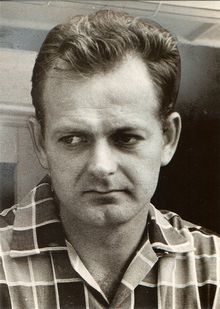William Lewis Moore facts for kids
Quick facts for kids
William Lewis Moore
|
|
|---|---|
 |
|
| Born | April 28, 1927 Binghamton, New York, U.S.
|
| Died | April 23, 1963 (aged 35) |
| Organization | Congress of Racial Equality |
| Movement | Civil Rights Movement |
William Lewis Moore (born April 28, 1927 – died April 23, 1963) was a brave postal worker. He was also a member of the Congress of Racial Equality (CORE). William Moore protested alone against racial segregation, which was unfair separation of people based on their race. He was sadly killed in Keener, Alabama, during a march. He was walking from Chattanooga, Tennessee to Jackson, Mississippi. His goal was to give a letter to Governor Ross Barnett, asking for equal rights for everyone.
Early Life and Activism
William Moore was born in Binghamton, New York. He grew up in both New York and Mississippi. Before he passed away, he lived in Baltimore, Maryland.
In the early 1950s, William Moore faced some health challenges. After getting better, he became an activist. He worked to help people with similar health issues. Over time, he also became involved in the Civil Rights Movement. This movement worked for equal rights for African Americans.
Moore joined the Congress on Racial Equality (CORE). In the early 1960s, he started three special protests. He marched to state capitals to deliver letters he had written. These letters spoke out against racial segregation.
His first march was to Annapolis, Maryland, the state capital. For his second march, he walked to the White House. He arrived around the same time that Rev. Martin Luther King Jr. was released from jail. This was after protests in Birmingham, Alabama. Moore's letter to President John F. Kennedy said he planned to walk to Mississippi. He offered to deliver any letters from the President along his way.
For his third protest, he planned a long walk. He started in Chattanooga, Tennessee. His goal was to reach Jackson, Mississippi. There, he wanted to give a letter to Governor Ross Barnett. He hoped the governor would agree to end segregation. During his march, he wore signs that said, "Equal rights for all & Mississippi or Bust."
The Final March
On April 23, 1963, William Moore was about 70 miles into his march. A reporter named Charlie Hicks from radio station WGAD interviewed him. This happened on U.S. Route 11 near Attalla, Alabama. The radio station had received an anonymous tip about Moore's location.
In the interview, Moore shared his plan. He said, "I intend to walk right up to the governor's mansion in Mississippi and ring his doorbell. Then I'll hand him my letter." The reporter was worried about Moore's safety. He offered to drive Moore to a motel. But Moore insisted on continuing his march.
Less than an hour after the reporter left, a driver found Moore's body. He was about a mile farther down the road. He had been shot twice in the head. The gun was traced to a man named Floyd Simpson. Moore had argued with Simpson earlier that day. However, no charges were ever filed against Simpson. William Moore died just one week before his 36th birthday.
Moore's letter was found and opened. In it, he wrote that "the white man cannot be truly free himself until all men have their rights." He asked Governor Barnett to "Be gracious and give more than is immediately demanded of you...."
Tributes and Legacy
Many people honored William Moore after his death. Folk singer Phil Ochs wrote a song about him. It was released on his album, A Toast to Those Who Are Gone. Another tribute song was written by German singer Wolf Biermann. Pete Seeger also sang "William Moore, The Mailman" on his album, Broadside Ballads.
On April 23, 2008, 45 years after Moore's death, Ellen Johnson and Ken Loukinen walked in his footsteps. They walked 320 miles from Reece City, Alabama. This was near where Moore was killed. They delivered William Moore's original letter to the capitol in Jackson, Mississippi. Bob Zellner, a long-time activist, joined them. He tried to give the letter to Governor Haley Barbour. However, the governor did not meet with them.
Memorials
On April 23, 2010, a memorial plaque for William Moore was unveiled. This was the 47th anniversary of his murder. The plaque is now on display at the Greater Binghamton Transportation Center. It is in Binghamton, New York.
William Moore was a pioneer in civil rights. He is the only white person featured in Investigation Discovery's "Injustice Files" from 2011.
Historical Marker
A special ceremony took place on Sunday, April 14, 2019. A historic marker was unveiled at the site where Moore was killed. The Alabama Historical Society helps place these markers. The Southern Poverty Law Center offered to pay for the marker. However, local historians wanted the money to come from the community. They believed it was important for local people to honor this tragic day. Local officials helped to pay for the marker. The Southern Poverty Law Center still made a donation to Keener Baptist Church for their help with the ceremony.

